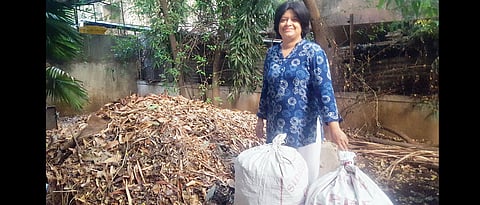

Dry leaves being burnt on the roadside and in building compounds is quite a familiar sight. For us, dry leaves are a nuisance, to be thrown away by the cleaners. The only way to quickly dispose it is setting heaps of them on fire. But did you know that dry leaves are important components for composting? So collect them for the green patch in your society or the terrace garden in your flat.
For Aditi Deodhar in Pune, the smoke was a constant irritant and she decided to look for other means of disposing of the leaves. That’s how she stumbled upon the information that dry leaves can be turned into very good compost and there is a huge demand for it. From this was born the Brown Leaf project, a non-profit group that connects dry leaves collectors with takers — gardeners and eco-conservationists in Pune.
With a Master’s degree in Industrial Mathematics with Computer Applications from Fergusson College, this woman is an unlikely eco-crusader. She tells us about how the project came to be, the switch in her career and the future ahead.
Interest in dry leaves
Like in every other household, there was a tree in my backyard and the cleaner would sweep the dry leaves into a heap and set them on fire. The smoke started bothering me, so I asked her to stop burning them. After a few days she came to me saying that the heap of dry leaves was large and had to be disposed some way or another. That’s when I realised that just telling people not to burn it isn’t enough, if there’s no alternative way of disposing it.
Leaves are bio-degradable and will eventually be absorbed into the eco-system but it is an extremely slow process, so not a feasible option. Although I had done a course from Ecological Society, my practical knowledge was still rudimentary when it came to this problem. That’s when I decided to seek help and ask others for a solution; I posted my problem on several chat groups. Luckily, I got in touch with Sujata Naphade who used to cultivate food for three families on her plot which was rented out to a builder. Construction debris had been dumped on her plot which rendered the soil infertile, so she wanted to make organic compost using dry leaves.
Setting up of Brown Leaf Project
When I visited Sujata’s plot, I realised how valuable a resource it is. In fact, Sujata required much more than all the leaves I could provide her, and this threw up an interesting supply-demand chain wherein the demand was much more than supply. Saving dry leaves for other gardeners and farmers to compost was a very new and alien concept. After research, I could figure out the important role that leaves play in this ecosystem.
Compost made from dry leaves is very useful for terrace gardening because it’s very light, easy to cart around, there’s no threat to building structure unlike wet compost which is heavier. For most though, the major hurdle is to access such huge amounts of dry leaves. Most societies now have exotic indoor plants which don’t have much dry leaves to begin with. So even though the demand existed, there were no points of accumulation or supply from nearby areas.
This is how the project was born in February 2016. I created online and social media platforms where people could connect for disposing as well as collecting dry leaves. There are no financial transactions involved in this process, it’s more like a discussion group.
Dry leaf in the cycle of nature
In nature, there’s no concept of waste because it’s a cyclic process. Waste generation is due to our lifestyle. It is important to reach out to people and change their perception that dry leaves are a waste.
First of all, even when dry, the leaves conserve a bit of the nutrients from the trees. Hence when we burn it, these nutrients are destroyed instead of going back into the earth. Secondly, leaves are the medium through which trees lose water and the shedding helps trees to conserve water during scarce seasons. Thirdly, when dry leaves cover the ground, it acts as a barrier against direct sunlight and the soil can retain its moisture — this is also the basis of mulching. With rains, the leaves decompose and the nutrients return to the soil.
They have social media groups where both leaf-donors and leaf-takers are present. The person who has dry leaves, collects them in gunny bags and drops a message on the group providing quantity and address.
Brown Leaf App is also available for download on Google Play Store where one can donate dry leaves.
